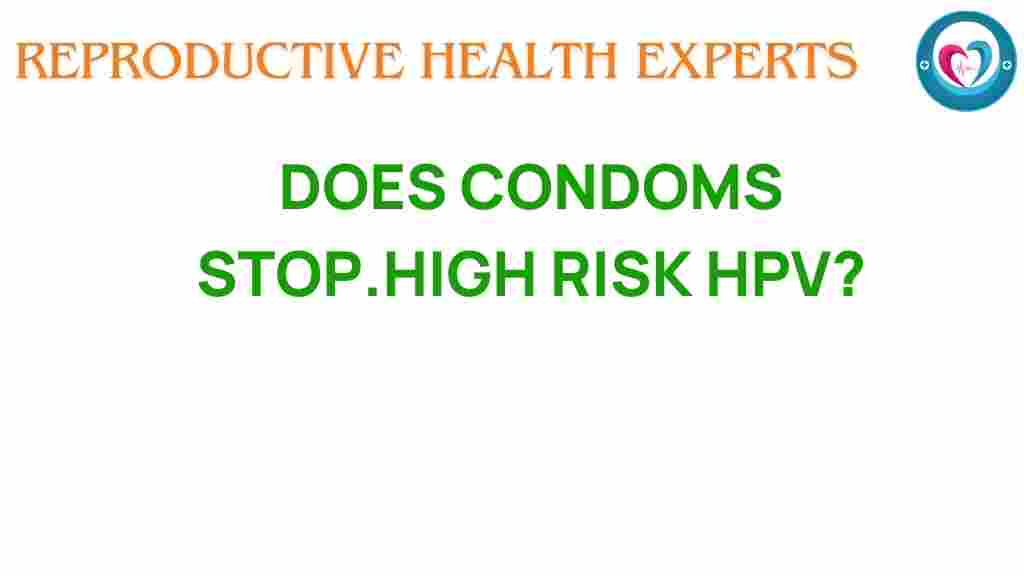Do Condoms Really Prevent High-Risk HPV? The Surprising Truth Revealed
Human Papillomavirus (HPV) is one of the most common sexually transmitted infections (STIs) worldwide. Among the various strains of HPV, some are categorized as high-risk due to their association with various forms of cancer, including cervical cancer. With the prevalence of HPV and the potential health risks it poses, many individuals wonder about the effectiveness of condoms in preventing high-risk HPV. In this article, we will explore the connection between condoms, HPV, and sexual health, aiming to uncover the truth behind common misconceptions.
Understanding HPV and Its High-Risk Strains
HPV is a group of over 200 related viruses, of which approximately 40 types can be transmitted through direct sexual contact. While many HPV infections are harmless and resolve on their own, high-risk strains like HPV 16 and 18 can lead to serious health issues, including:
- Cervical cancer
- Anal cancer
- Oropharyngeal cancers
- Pena cancer
Vaccines are available that can protect against the most common high-risk HPV strains, but understanding how to mitigate the risk through safe practices is equally important.
How Do Condoms Work in STI Prevention?
Condoms are a barrier method of contraception that can significantly reduce the risk of STIs, including HPV. When used correctly and consistently, they provide a physical barrier that prevents the exchange of bodily fluids and skin-to-skin contact during sexual activity. However, their effectiveness varies depending on the type of STI.
The Role of Condoms in HPV Prevention
While condoms can reduce the risk of HPV transmission, they do not provide complete protection. This is primarily because:
- HPV can be present in areas not covered by a condom.
- Skin-to-skin contact can occur in areas not shielded by the condom.
Studies indicate that consistent condom use can lower the likelihood of acquiring high-risk HPV strains, but it is not 100% effective. According to the Centers for Disease Control and Prevention (CDC), the consistent use of condoms can reduce the risk of HPV transmission by about 70%.
Misconceptions About Condoms and HPV
There are several misconceptions about the effectiveness of condoms in preventing HPV. Understanding these misconceptions can help improve public health outcomes:
- Myth 1: Condoms provide complete protection against HPV.
- Myth 2: You can only get HPV from penetrative sex.
- Myth 3: Once you have HPV, you can’t get it again.
It is essential to understand that while condoms are a vital tool in preventing STIs, they are not a foolproof method against HPV.
The Importance of Safe Sex Practices
Engaging in safe sex practices is crucial for protecting against STIs, including HPV. Here are some essential tips to ensure better sexual health:
- Use Condoms Consistently: Always use condoms during any sexual activity, including oral, vaginal, and anal sex.
- Get Vaccinated: The HPV vaccine is effective in preventing the most common high-risk strains.
- Regular Screenings: Women should undergo regular Pap tests and HPV screenings as recommended by healthcare providers.
- Limit Number of Sexual Partners: Reducing the number of sexual partners can decrease the risk of exposure to HPV.
- Communicate with Partners: Discuss sexual health history with partners to make informed decisions.
Step-by-Step Guide to Practicing Safe Sex
Here is a step-by-step guide to practicing safe sex and reducing the risk of HPV:
- Educate Yourself: Understand the risks associated with STIs, including HPV.
- Purchase Condoms: Buy high-quality latex or polyurethane condoms, and check the expiration date.
- Communicate: Talk to your partner about safe sex practices and STI testing.
- Use Condoms Correctly: Ensure proper use of condoms to maximize effectiveness.
- Get Vaccinated: Schedule an appointment to receive the HPV vaccine if eligible.
- Stay Informed: Keep up with regular health screenings and follow-up appointments.
Troubleshooting Common Issues
Here are some common issues individuals may face when using condoms and tips to troubleshoot them:
- Condom Breakage: Ensure the condom is not expired and is stored in a cool, dry place. Use water-based or silicone-based lubricants to reduce friction.
- Allergic Reactions: If you experience irritation, consider switching to non-latex condoms made of polyurethane or polyisoprene.
- Slippage: Ensure the condom is properly fitted and has been applied correctly to prevent slippage.
Conclusion: The Takeaway on Condoms and HPV Prevention
In conclusion, while condoms are an essential tool in the prevention of high-risk HPV and other STIs, they are not a guaranteed method of protection. Understanding the limitations of condoms, combined with safe sex practices such as vaccination and regular screenings, can significantly reduce the risk of HPV transmission.
By educating ourselves and dispelling misconceptions surrounding HPV and condom use, we can improve our sexual health and contribute to better public health outcomes. Always prioritize communication with partners and stay informed about your sexual health.
For more information on HPV and its prevention, check out the CDC’s HPV page. Additionally, for resources on safe sex practices, visit this helpful guide.
This article is in the category Prevention and created by ReproductiveHealthExperts Team
